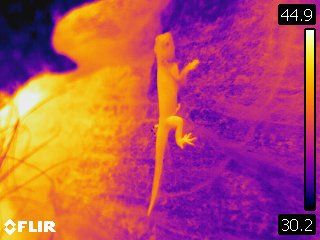Some like it hot: thermal imaging agamas in the fynbos
In addition to behavioral observations, part of my recent duties for the project I'm currently working on has been to capture thermal images of our agama study subjects (Agama atra). This is certainly one of the more fascinating aspects of the project and I thought I'd share some of the images here (used with permission):


Thermal imaging allows for detailing the temperature properties of both the animal itself and that of its environment
Physiological thermoregulation
To some extent, reptile body temperature can be controlled by the animal controlling blood flow (i.e. rate of circulation). Increasing their heart rate for example (and dilating blood vessels) will increase rates of heat transfer between their body and the environment when ambient temperatures are high (and vice versa during periods of cooling). Blood flow may be directed to areas such as limbs during periods of high body temperature, where the heat will be more easily lost. More importantly for animals such as these agamas, behavioural mechanisms are also used to control temperature.
Behavioural thermoregulation
Being ectothermic, naturally these animals must rely mainly on environmental heat to reach an optimal temperature. For a lizard, this involves both basking directly in the sun, and thigmothermy (heating themselves through close contact with the substrate). Generally, when conditions are cooler out, you'll spot these little fellows huddled tightly to the rock face, absorbing every bit of available heat from contact with the surface below. As conditions become warmer, they resort more to basking, with the upper portion of the body away from the rock face:


Agamas move from hotter to cooler (or vice versa) areas in their environment to maintain body temperature within a thermal optimum
Of course, as temperatures become too hot, the lizards stand a chance of overheating as well. Under very hot conditions, it's not unusual to see them seeking out cooler options on the shaded side of a rock or even deep within crevices, where temperatures are more to their liking. Using these strategies, they seem to be pretty adept at maintaining their temperature near their thermal optimum, even when ambient conditions are not in alignment with that optimum.


Thermoregulation may involve the use of sheltered sites and crevices during the heat of the day
Capturing it on camera
Our challenge is to try and photograph this behaviour in as natural a way as possible, preferably without disturbing the animal of course, so that the thermal properties of the immediate area are recorded as well. Fortunately, these agamas are fairly habituated to human presence, thus most of these images have been taken from as little as a meter away.
All told, this aspect of the project has definitely been the most interesting for me personally. I hope you've enjoyed this glimpse into the thermal world of the agamas as well :)
For a more in depth look at behavioural and physiological thermoregulation check out:
https://www.researchgate.net/profile/Frank_Seebacher/publication/7698879_Physiological_mechanisms_of_thermoregulation_in_reptiles_A_review/links/0912f5087121f28699000000.pdf
http://nzetc.victoria.ac.nz/tm/scholarly/tei-Bio24Tuat02-t1-body-d2.html
All images here are my own taken during the course of the current project and used with permission,
Happy Steeming people,
The Wise Fox
Super neat stuff! It also makes me glad for how good human temperature regulation adaptations are- both biological and technological.
Yes, it would suck to have to spend most of your day 'maintaining your optimum temperature' right? 😂
Well, that part, yes- the lounging around lazily most of the day part doesn't sound too terrible.
Eh, I'd get bored!
ahh that's so cool! It's so interesting to see them change so drastically in temperature. I know about reptiles and the whole cold-blooded thing, but I've never actually seen it in this kind of a visual context. I wish I could set up a camera like this in front of my snake tank and take pictures of him for a 24 hour cycle, so I could get an idea of how he's using the setup he's got.... :P
Well, from what I know of lab trials with lizards in a tank where a thermal gradient is maintained, they tend to hang out in one specific spot that represents their thermal optimum (this is basically how their optimum is determined experimentally). So if there's one spot he spends most of his time in that's probably the perfect temperature spot. What sort of snake is he, btw? 🙂
ah, well that does make sense, logically lol! He is a standard north american corn snake - he's 18 years old and is currently about 6' long (give or take). I bought him when he was only about 6 inches long :3 And his favourite place to hang out is in his peet moss filled tupperware. I suppose he likes the humidity in there, which is not really what I expected based on my previous experience with california native snakes, but he seems to be one pretty happy creature so I'm not going to argue with him. :P
It sounds like he's pretty damn happy, yeah, if he's already on his 18th year :) it's a great feeling to rear some creature from little and watch it thrive :)
I cant decide if Cold blooded is a lot of work or just chilling in the sun all day.
For some reason I have always wanted a flir camera I have literally zero practical uses for one but they just seam really fun pity they have such high cost.
Ah yeah, there's lots of gadgets I want 'just because.' Really regretting not picking up a camera trap before this season, and I really want one of those bat detectors that you can use to eavesdrop on bats flying by 😬
Being A SteemStem Member